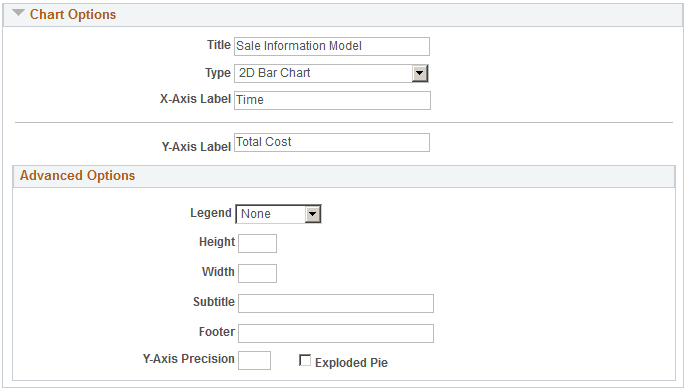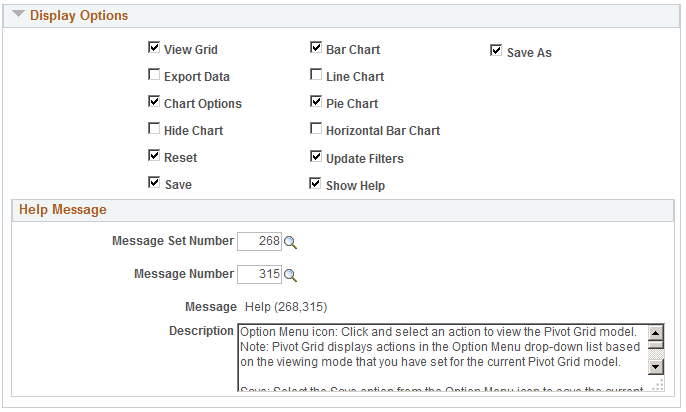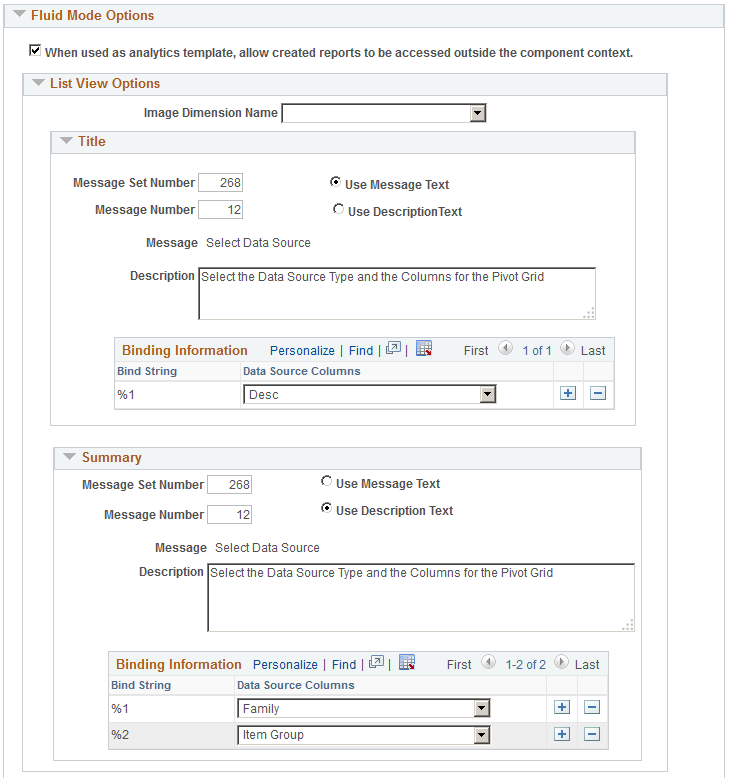Specifying Data Model Options
Use the Specify Data Model Options (PTPG_WIZ_OPT) page to define the initial layout of the grid and the chart.
Navigation
Access the Specify Data Model Options page by selecting the Next button on the Specify Data Model Values page.
Image: Specify Data Model Options page
This example illustrates the fields and controls on the Specify Data Model Options page. Definitions for the fields and controls appear following the example.

This page has six main sections: View Options, Grid Options, Chart Options, Display Options, and Fluid Mode Options. Each section can be expanded or collapsed.
Expand to display the view options.
|
Field or Control |
Definition |
|---|---|
| Default View |
Define Pivot Grid view options for the grid and the chart. Available options are:
|
| Grid Axis and Chart Axis |
Select the initial grid and chart layout. Note that:
You can set multiple columns as Y axes, and these Y axes will be plotted as series on the charts. This feature has these limitations:
Note: The behavior of the Multiple Y axes feature applies to both classic and fluid views. In addition for fluid viewer, you have the option to control the behavior when you select facts in the column area that are displayed in the fluid viewer. See Fluid Mode Options. |
| Display As |
The Display As column is available only for number (facts) fields. Select either the Percentage or the Percentage Grand Total option to display the number (fact) values in the grid and chart. Select display as Percentage if you want to show the data point in percentage. Select display as Percentage Grand Total if you want to show the calculated percentage of the data point on the grand total of the field. |
| Dual Y-axis |
This option is available for the columns that are set to Y axis. Select an option to set the corresponding Y axis column as a dual Y axis on the Pivot Grid charts; this means that the system will display a second Y axis on the chart. The values for the second Y axis will be plotted like a Series on the chart. Note that:
Note: The behavior of the Dual Y axis feature applies to both classic and fluid views. |
| Define Threshold |
Click to access the Configure Thresholds page, where you can configure the basic threshold settings for the grids and the charts. All threshold settings are applied for both classic and fluid views. For detailed description see, Configuring Thresholds. |
| Next |
Click to advance the wizard to the next page. |
Use the Grid Options section to define Pivot Grid view options for the grid and the chart.
Image: Grid Options section
This example illustrates the fields and controls in the Specify Data Model Options page - Grid Options section. Definitions for the fields and controls appear following the example.

|
Field or Control |
Definition |
|---|---|
| Collapsible Data Area |
Select to allow viewers to collapse the data area. |
| Expanded State |
Select to have the initial view expanded. |
| No Drag and Drop |
Select if you do not want users to have the ability to drag and drop filters, rows, and column axes. |
Expand the Chart Options section to enter additional chart options.
Image: Chart Options section
This example illustrates the fields and controls on the Specify Data Model Options page - Chart Options section. Definitions for the fields and controls appear following the example.

|
Field or Control |
Definition |
|---|---|
| Title |
Enter a title for your chart. By default, the Pivot Grid model name is used. |
| Type |
All PeopleSoft chart types are available, including:
|
| X-Axis Label |
Enter a label for the X axis. By default, the field name for the X axis is used. |
| Y-Axis Label |
Enter a label for the Y axis. By default, the field name for the Y axis is used. |
| Advanced Options |
Define display options for the chart, including chart legend, and height and width of the chart. |
| Legend |
Select a legend for the chart. The available options are Bottom, Left, None, Right, and Left. By default, the None option is selected. |
| Y-Axis Precision |
Enter the number of decimal places in the Y-axis values. For example, when the Y-Axis Precision has a value of 2, the Y-axis in the chart has two decimal values. Note: When the pivot grid display is a pie chart type then the Y-Axis Precision is disabled and considered as 0. |
| Exploded Pie |
Select to view the 2D or 3D charts with exploded sectors. |
Use the Display Options section to hide chart icon shortcuts and to disable menu options in the Pivot Grid display. This configuration is at the model level and is applicable for all views.
For example, if the Hide Chart, Pie Chart, and Horizontal Bar Chart options are deselected in the Display Options section, then in the Pivot Grid display, the Hide Chart option in the Option Menu drop-down list is disabled and the Pie Chart and the Horizontal Bar Chart icons are invisible.
Image: Display Options section
This example illustrates the fields and controls on the Specify Data Model Options page - Display Options section with the Export Data, Hide Chart, Line Chart, and Horizontal Bar Chart options deselected.

Image: Pivot Grid display without some viewer options
This example illustrates the Pivot Grid fluid view. The Export Data and Hide Chart options are not listed in Options Menu, and the Pie Chart and Horizontal Bar Chart icons are invisible.

Note that following points when you set the values in the Display Options section:
If no view option is selected in the Display Options section and if all prompts are set to invisible, then the Options Menu is invisible in Pivot Grid Viewer.
You can selectively show and hide prompts using the Select Query Prompt Values section in the Pivot Grid Wizard – Specify Data Model Values page.
If the Show Help option is selected, the embedded Help icon is available in the Grid Viewer page.
Note: The Help icon is shown only in the classic viewer and it is unavailable in Fluid viewer.
Use the Help Message section to define the help information. The default help message is from message set number 268, and the message number 315. The message catalog entry is parsed for special placeholders %PBCTXT(PTPG_PSPGVIEWER). Note that the Help URL field in the Web Profile Configuration page must be specified (by selecting PeopleTools, Web Profile, Web Profile Configuration).
See Entering Embedded Help Messages in the Message Catalog in Configuring Embedded Help for Scroll Areas and Grids.
Use the Specify Data Model Options page - Fluid Mode Options section- List View Options region to define the list view options for the pivot grid model. The list view options include the title and the summary for each row of result. The Title and Summary regions use the dimension values that are part of the detail grid. When designing the pivot grid model, application developers create the title and summary text from message catalog entries. The bind values for the message catalog are passed from the dimensions, facts, and display columns.
See the Message Catalog section in Using Administration Utilities
Note: The list view options are also available at the Views Configuration page (Pivot Grid Wizard, Configuration Pivot Grid View link). These properties can be configured at each view level. The Views Configuration page for pivot grids overrides the Fluid Mode Options at the view level.
Image: Fluid Mode Options - List View Options
This example illustrates the fields and controls on the Specify Data Model Options page - Fluid Mode Options section - List View Options region.

Use the Specify Data Model Options page - Fluid Mode Options section - Viewer Options region to define the result view for the pivot grid model.
Image: Fluid Mode Options - Viewer Options
This example illustrates the fields and controls on the Specify Data Model Options page - Fluid Mode Options section - List View Options region.

Field or Control
Definition
Result View The Result View can be set to Grid, List, or Grid and List.
Default Result View If the Result View option is set to Grid and List for the fluid mode, the Default Result View section enables you to configure whether the list view or the grid view is available in the detail view.
Allow Multiple Y Axes Select this option to allow users to select multiple Y Axes on the chart. If this option is deselected, any change to the Y axis will result in a single Y axis being plotted on the chart.
Hide Chart Select this option to hide the chart when you view the pivot grid model in the fluid mode.
Result View Columns By default, all the display type columns, axis rows, filters, and facet fields appear in the detail view (as in the classic Pivot Grid Viewer). You can deselect any column in the Result View Columns section to hide that column in the fluid view.
Use the Specify Data Model Options page - Fluid Mode Options section - Facet Selection region to set the facet display options to display the single-select and multi-select facets as charts and as lists in fluid views. In the chart facets, you can drill down by clicking the chart data point in the facets. Note that the chart data point is highlighted after your selection.
Image: Fluid Mode Options - Facet Options
This example illustrates the fields and controls on the Specify Data Model Options page - Fluid Mode Options section - Facet Selection region, which is where you set the chart types for the facets. The Contract Type facet is set to appear as a Pie chart and the Contract Status is set to appear as Bar chart.

Use the Specify Data Model Options page - Fluid Mode Options section - Drilling URL Options region to define how mapped drilling URLs will appear in fluid view. The available options are Full Page Modal, Modal Window, New Window, and Replace Window.
Image: Fluid Mode Options - Drilling URL Options
This example illustrates the columns on the Specify Data Model Options page - Fluid Mode Options section - Drilling URL Options region.

Note: PeopleSoft recommends that you set your drilling URLs to open in a new window for all external drilling URLs and classic components. For pages with fluid views, the Replace Window and Modal Window options are recommended.
The size of the modal window is controlled by the target page’s min-width and min-height settings, which is similar to any fluid modal. In smart phones, the target page is displayed as full page modal automatically when the column is configured to use the Modal window option.